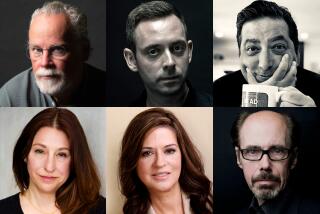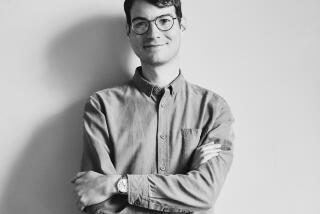Puzzle of a Polish Childhood : WHO WAS DAVID WEISER?, <i> By Pawel Huelle (Harcourt Brace Jovanovich: $17.95; 304 pp.) </i>
- Share via
The Jew with mysterious powers--magical, criminal, financial, sexual--haunts European literature from Chaucer to the present day, and almost invariably the role has been a villainous one. In his first novel, Pawel Huelle, a former Solidarity press officer, daringly revises this persistent myth in a coming-of-age story set in postwar Poland. By contrasting the seductive mysteries and innocence of childhood with the absurd yet serious agendas of adults, Huelle subtly illuminates the way in which one’s daily concerns are inexorably overshadowed by history and fate.
When the Jelitkowo beach, inundated with millions of rotting fish, is closed down right at the start of the summer vacation, many of Gdansk’s doomsayers are quick to see the event, along with the continuing drought, as one more sign of God’s wrath. For Piotr, Szymek and narrator Heller, three quite ordinary youths growing up in the late 1950s, this catastrophe destroys their chief summer activities.
Their ensuing boredom and search for new amusement turns the vacation in an entirely unexpected direction, as they come gradually under the sway of David Weiser, an enigmatic and precocious Jewish boy their own age. The remote and imperious Weiser, who is always heading off on mysterious missions with Elka, his accomplice and go-between, now begins to invite the three boys along as well. Bit by bit his innate authority, impressive and arcane knowledge, and quasi-magical powers open up a world lying far outside the realm of their experiences. He meticulously seduces them into his peculiar educative program for reasons he never addresses, though the implications of Weiser’s revelations and entire being continue to haunt the narrator down to the present day.
On one secret outing, Weiser hypnotizes a panther at the zoo, simply by staring at it. Another time he produces a real German gun that he lets the other boys play with. Not normally athletic, he shows up one afternoon just in time to win a crucial soccer game through extraordinary physical skills. And once, while Elka plays a stolen set of panpipes, the boys watch, flabbergasted, as Weiser dances maniacally, speaks in tongues, collapses and then actually levitates a few feet off the ground--or so the narrator continues to think, though the whole experience is too strange for the boys to really take in.
When Weiser finally reveals a hidden room in an abandoned brickyard, stocked with weapons and ammunition, his powers are incontestable. After teaching the boys to shoot, his curriculum climaxes in allowing them to watch his detonation of a series of unexploded bombs left over from the war. Each explosion is more powerful than the last; each he has also packed with colored powders to produce a striking visual accompaniment to the violence.
Finally, in the midst of calculating the precise placement of a bomb which would dam up the river to form a swimming pool, Weiser and Elka simply disappear without a trace, from the middle of a culvert, right under the noses of the others. This impossible vanishing act results in the detainment and harsh questioning of Piotr, Szymek and Heller, which is where this multilayered novel actually begins.
Separately and together, the boys are hauled, over and over, before a militiaman, their headmaster and their ludicrously pedantic nature instructor, who is very fond of corporal encouragements like ear-pulling, nose-twisting and hand-caning. These three authorities want a simple and consistent account of the deaths of Weiser and Elka, but because of their loyalty to the essential mystery of Weiser, and because of their own legitimate confusion, this is something the boys cannot provide.
The narrative turns again and again from the interminable questioning, to a measured account of the summer’s many incidents, to the narrator’s adult reflections on his continued obsession with Weiser, and back again. So smoothly and rhythmically are these separate strands woven together that, even though we know much of the factual outcome of the novel right from the start, we still have a sense of continual discovery. We’re gently made aware that we are reading both a story redolent of childhood’s minute particulars and an allegory on the passing of cultures, lives and time.
All the sounds, smells, and tastes of youth are richly and simply conveyed, as in this passage: “The first thing in the morning, my mother sent me to Cyrson’s for greens. I liked going there. Inside, it was cool and smelled of vegetables; there were boxes crammed with the first green apples of the season; and from glass jars gumdrops and candy mice beckoned, twenty-five groszy apiece. The owner’s wife, who served the customers from behind a wooden counter, had breasts as large and round as mixing bowls. . . . If there was a zloty’s change left over from the shopping, I could . . . drink orangeade from a bottle with a spring-top porcelain cap. Opening these bottles as you sat on the concrete steps at the entrance was an important ritual. If the seal was good and no tiny bubbles were escaping, you’d shake the bottle first, and the cap, gently prized up, would fly off by itself with a loud pop. . . . In those days orangeade came in two different colors; usually it was yellow, but sometimes it was red, an especially pretty red, and even now I’d swear on a stack of Bibles that the red variety had a stronger bouquet and was more carbonated.”
The boredom, madness and comedy of neighborhood life, the ill will between Catholic and communist, husband and wife, the ever-present reminders of the war’s destruction--all these things are sensitively and amply rendered. But it’s the narrator’s probing concern with the meaning of his own text that brings an added dimension to the novel. Every detail of childhood, every event of that fateful summer, whether caused by Weiser or not, is linked, in the narrator’s mind, with his troubled question, that of the book’s title. Though he might refer to “the unwritten book about Weiser” or declare, “I’m not writing a book about Weiser,” his statements only reinforce his view that the entirety of the vanished past is a code to be deciphered, even if the mystery it contains will never be solved.
The most poignant sections of the book detail the narrator’s adult visits to Szymek, Elka (who has in fact survived) and the grave of Piotr, to query each of them about David Weiser, what “really” happened, and the meaning of it all. Each of the three in a separate way, he finds, has refused Weiser’s legacy, has incorporated it into the fabric of rational adult life (or irrational death), and thus can no longer help him with his unanswerable, perhaps unaskable, questions.
Pawel Huelle’s artful and evocative novel, beautifully paced and ingeniously constructed, is a subtle meditation on childhood, fate and history, as well as a thoroughly engrossing tale.
More to Read
Sign up for our Book Club newsletter
Get the latest news, events and more from the Los Angeles Times Book Club, and help us get L.A. reading and talking.
You may occasionally receive promotional content from the Los Angeles Times.






